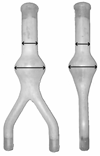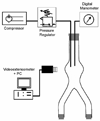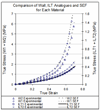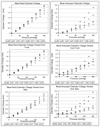Engineering silicone rubbers for in vitro studies: creating AAA models and ILT analogues with physiological properties
- PMID: 20524746
- PMCID: PMC2882675
- DOI: 10.1115/1.4000156
Engineering silicone rubbers for in vitro studies: creating AAA models and ILT analogues with physiological properties
Abstract
In vitro studies of abdominal aortic aneurysm (AAA) have been widely reported. Frequently mock artery models with intraluminal thrombus (ILT) analogs are used to mimic the in vivo AAA. While the models used may be physiological, their properties are frequently either not reported or investigated. This study is concerned with the testing and characterization of previously used vessel analog materials and the development of new materials for the manufacture of AAA models. These materials were used in conjunction with a previously validated injection molding technique to manufacture AAA models of ideal geometry. To determine the model properties (stiffness (beta) and compliance), the diameter change of each AAA model was investigated under incrementally increasing internal pressures and compared with published in vivo studies to determine if the models behaved physiologically. A FEA study was implemented to determine if the pressure-diameter change behavior of the models could be predicted numerically. ILT analogs were also manufactured and characterized. Ideal models were manufactured with ILT analog internal to the aneurysm region, and the effect of the ILT analog on the model compliance and stiffness was investigated. The wall materials had similar properties (E(init) 2.22 MPa and 1.57 MPa) to aortic tissue at physiological pressures (1.8 MPa (from literature)). ILT analogs had a similar Young's modulus (0.24 MPa and 0.33 MPa) to the medial layer of ILT (0.28 MPa (from literature)). All models had aneurysm sac compliance (2.62-8.01 x 10(-4)/mm Hg) in the physiological range (1.8-9.4 x 10(-4)/mm Hg (from literature)). The necks of the AAA models had similar stiffness (20.44-29.83) to healthy aortas (17.5+/-5.5 (from literature)). Good agreement was seen between the diameter changes due to pressurization in the experimental and FEA wall models with a maximum difference of 7.3% at 120 mm Hg. It was also determined that the inclusion of ILT analog in the sac of the models could have an effect on the compliance of the model neck. Ideal AAA models with physiological properties were manufactured. The behavior of these models due to pressurization was predicted using finite element analysis, validating this technique for the future design of realistic physiological AAA models. Addition of ILT analogs in the aneurysm sac was shown to affect neck behavior. This could have implications for endovascular AAA repair due to the importance of the neck for stent-graft fixation.
Figures








Similar articles
-
In vitro evaluation of the effects of intraluminal thrombus on abdominal aortic aneurysm wall dynamics.Med Eng Phys. 2011 Oct;33(8):957-66. doi: 10.1016/j.medengphy.2011.03.005. Epub 2011 Apr 7. Med Eng Phys. 2011. PMID: 21478044
-
On the Relative Effects of Wall and Intraluminal Thrombus Constitutive Material Properties in Abdominal Aortic Aneurysm Wall Stress.Cardiovasc Eng Technol. 2025 Feb;16(1):66-78. doi: 10.1007/s13239-024-00757-8. Epub 2024 Oct 28. Cardiovasc Eng Technol. 2025. PMID: 39466593
-
Intraluminal thrombus and risk of rupture in patient specific abdominal aortic aneurysm - FSI modelling.Comput Methods Biomech Biomed Engin. 2009 Feb;12(1):73-81. doi: 10.1080/10255840903077170. Comput Methods Biomech Biomed Engin. 2009. PMID: 18651282
-
Influence of aneurysm wall stiffness and the presence of intraluminal thrombus on the wall movement of an aneurysm - an in vitro study.Vascular. 2012 Aug;20(4):203-9. doi: 10.1258/vasc.2011.oa0324. Epub 2012 Jun 1. Vascular. 2012. PMID: 22661613
-
The Detrimental Role of Intraluminal Thrombus Outweighs Protective Advantage in Abdominal Aortic Aneurysm Pathogenesis: The Implications for the Anti-Platelet Therapy.Biomolecules. 2022 Jul 5;12(7):942. doi: 10.3390/biom12070942. Biomolecules. 2022. PMID: 35883500 Free PMC article. Review.
Cited by
-
Fabrication, characterization and numerical validation of a novel thin-wall hydrogel vessel model for cardiovascular research based on a patient-specific stenotic carotid artery bifurcation.Sci Rep. 2024 Jul 15;14(1):16301. doi: 10.1038/s41598-024-66777-5. Sci Rep. 2024. PMID: 39009618 Free PMC article.
-
Effect of manufacturing and experimental conditions on the mechanical and surface properties of silicone elastomer scaffolds used in endothelial mechanobiological studies.Biomed Eng Online. 2017 Jul 14;16(1):90. doi: 10.1186/s12938-017-0380-5. Biomed Eng Online. 2017. PMID: 28705250 Free PMC article.
-
Biomechanical Investigation of Disturbed Hemodynamics-Induced Tissue Degeneration in Abdominal Aortic Aneurysms Using Computational and Experimental Techniques.Front Bioeng Biotechnol. 2019 May 31;7:111. doi: 10.3389/fbioe.2019.00111. eCollection 2019. Front Bioeng Biotechnol. 2019. PMID: 31214581 Free PMC article. Review.
-
3D-Printed Tissue-Mimicking Phantoms for Medical Imaging and Computational Validation Applications.3D Print Addit Manuf. 2014 Mar 1;1(1):14-23. doi: 10.1089/3dp.2013.0010. 3D Print Addit Manuf. 2014. PMID: 28804733 Free PMC article.
-
Mechanical properties and fibrin characteristics of endovascular coil-clot complexes: relevance to endovascular cerebral aneurysm repair paradigms.J Neurointerv Surg. 2015 Apr;7(4):291-6. doi: 10.1136/neurintsurg-2013-011076. Epub 2014 Mar 25. J Neurointerv Surg. 2015. PMID: 24668257 Free PMC article.
References
-
- Sakalihasan N, Limet R, Defawe OD. Abdominal Aortic Aneurysm. Lancet. 2005;365(9470):1577–1589. - PubMed
-
- Li Z, Kleinstreur C. Fluid-Structure Interaction Effects on Sac-Blood Pressure and Wall Stress in a Stented Aneurysm. Journal of Biomechanical Engineering. 2005;127(4):662–671. - PubMed
-
- Office of Population Censuses and Surveys. Mortality Statistics, England and Wales. London HMSO; 1989.
-
- Chong CK, How TV, Black RA, Shortland AP, Harris PL. Development of a Simulator for Endovascular Repair of Abdominal Aortic Aneurysms. Annals of Biomedical Engineering. 1998;26(5):798–802. - PubMed
-
- Chong CK, How TV, Gilling-Smith GL, Harris PL. Modelling Endoleaks and Collateral Reperfusion Following Endovascular AAA Exclusion. Journal of Endovascular Therapy. 2003;10(3):424–432. - PubMed
Publication types
MeSH terms
Substances
Grants and funding
LinkOut - more resources
Full Text Sources

